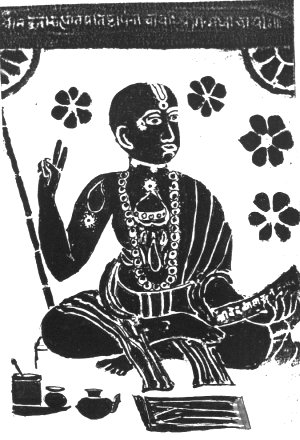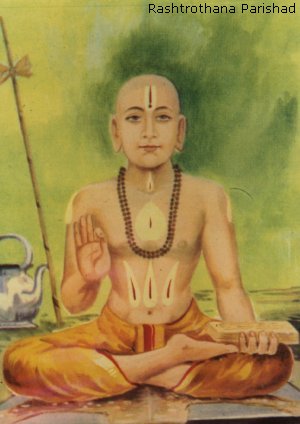Saint Madhvacharya (1238-1317)
by Dr.(Mrs.) Jyotsna Kamat
First Online: October 04, 2002
Page Last Updated: December 07, 2024
Introduction | Important
Proponents | Pictures
Alvars | Shankara |Bridal Devotion | The
Alvars | Ramanuja | Madhva | Ravidas
Meerabai | Guru Nanak | Chaitanya | Purandaradas
Ramananda | Kabir | Tukaram | Kanakadas
Madhvacharya or Anandatirtha (also Poornaprajna) is one of the three great acharyas of Hinduism who interpreted Hindu philosophy as revealed in ancient texts like the Vedas, Upanishads, Bhagavadhita, and the Bhagavata Purana.
Shankaracharya (7th century A.D.) preached Advaita or Monism -- "God only is true, this world is an illusion". Ramanujacharya (12th century) preached a blend of monism and dualism. "Since God is the soul of universe, He is real. Hence his creation, i.e., human soul is also real." he propounded. Whereas Madhvacharya believed that the universe is a playfield of God. "Man is only a tool in his hands". For him, world was not an illusion. It was a school, meant to study God's greatness.
Madhva was born on the Vijayadashami day of 1238 A.D. to a pious couple Nadillaya Narayan Bhatta and Vedavati, in a village Pajaka near Udupi ( in present day Karnataka). His earlier name was Vasudeva.
© K. L. Kamat

Guru Madhvacharya
He was a brilliant child endowed with prodigious memory and could grasp lessons at one sitting. Most of the time he used to spend in sports and games of the period like trekking, wrestling, weight lifting and swimming. hH out beat his contemporaries in all and was known to be fearless. He had a resonant, pleasant voice and people flocked to listen to his chanting shlokas and discourses in the temple.
He had spiritual leaning from a young age and sought his father's permission to become a monk (sanyasin). The parents were very sad because Vasudeva was their only surviving child and they had nobody to look after them in their old age. Hence Vasudeva waited till a brother was born. This brother, Vishnuchitta, performed the duty of a son, and became an ascetic late in life, being initiated by his elder brother. Vishnuchitta is considered a great exponent of Madhva philosophy.
Vasudeva underwent rigorous training under a great guru named Achyutapreksha. But he had doubts about interpretation of earlier scholars on the nature of God. He evolved his own theory of dualism (dwaita) which is also known today as "tattvavada." He undertook country-wide tour of India, from Kanyakumari in the South to Badari in the Himalayas to propagate his teachings. As was the tradition, every new exponent had to give new interpretation to the sacred texts and establish its superiority in the assemblies of the learned. Vasudeva who by now had assumed the name Madhvacharya succeeded wherever he went due to his clear thinking, oratory, debating skills and earned not only fame, but distinguished disciples as well. Of them Padmanabhateertha from Godavari region, and Narahariteertha from Kalinga region are more famous.
India was having troubled times, not only politically, but on religious front as well. Islam was spreading and Muslim rulers in Delhi were getting firmly rooted. There were squabbles among various religious sects to establish superiority. Madhva's appearance on the scene provided a healing touch to many harassed and confused devotees and his simple and effective way of preaching, helped the real devotees to realize the path of devotion and finally liberation.
"There is one God, the embodiment of positive Divinity. He is "Narayana." He is also Ishwara Brahma, Vishnu, and has many other names. You can address Him by any name." -- he preached.
"This world is God's reflection. Through this reflection only one has to try hard to realize God." -- he exclaimed.
"The entire nature extols God. His existence is evident in the sounds of sea, in the wind in singing of birds and howls of beasts. These all pay homage to God. his existence should be recognized which is possible after self-training." he advised. He gave new interpretation to caste system prevailing during his times. (Actually he was nearer to Vedic seers in this aspect.) The caste was related more to one's nature than his/her birth. Birth was not important to determine caste. It signified one's behavior or nature. A spiritually enlightened chandala (outcaste) was better than an ignorant brahmin." People were drawn to his teachings.
By the time Madhva returned to Udupi he had good number of followers. The installation of Lord Krishna's image in the Udupi temple and establishment of eight mathas (known as the ashamathas) marked his great achievement of this period.
Legend exists that there was a ship-wreck near the town of Malpe when a storm
broke. Madhva had a dream that there was an idol of Lord Krishna in the ship and
he had to salvage it from the seabed. He got the fisher-folk into the waters and
could get the ancient image which he got installed at the temple, which is a great
shrine today.
See Also: Town of Udupi -- Photo album of the elephants, temples, arts, and people of the town of Udupi in Karnataka
As was the practice, establishment of mathas near the temple came up. Not one, but eight in consecutive order! These are Palimar, Admar, Sirur, Kaniyur, Pejawar, Krishnapur, Puttige and Sode, each headed by versatile disciples of the great acharya. The peculiarity of the Ashtamathas is that, the management of these mathas is by turn (paryaya) and each swami or Pontiff has to manage administration for two years. Perhaps the great preceptor evolved his own democratic way of managing complete hegemony over a religious establishment.

Philosopher Madhvacharya
Dwaita philosophy became very popular in the south, west as well as east. Chaitanya Mahaprabhu of Gouda (present day Bengal) was highly influenced by dualism, so were many saints of west India. Karnataka has great saints and preachers like Purandaradasa and Kanakadasa who had faith in Madhva tenets. Madhvacharya wrote about forty books including commentaries on Upanishads, Gita, analysis of Mahabharata and Purnanas, and Rigveda. Curiously enough Tantrasara Sangraha, a book on iconography is ascribed to him, as also one on mathematics, proving his versatility. His musical composition Dwadasa stotra is quite popular among Vaishnava devotees.
Madhvacharya had to face a lot of opposition due to his preaching which were quite opposite to established norms of worship and belief. Tradition exists that his commentaries (on palm leaf books) were stolen and destroyed. There is a story depicting his fearlessness in crossing a flooded river, facing armed robbers in a forest and a Muslim king who had no sympathy towards Hindu monks. He spoke to the sultan in Persian, convincing him that his Allah and his own Narayana are one and the same. " We are all citizens of His Kingdom."
At the age of 79, the acharya left for his final pilgrimage from Udupi to Badari--never to be seen again. Madhva Navami is observed in his memory. The temple town of Udupi bears Madhva's memory at every step with eight mathas and innumerable followers, who throng everyday throughout the year.
![]()
Introduction | Important
Proponents | Pictures
Alvars | Shankara |Bridal Devotion | The
Alvars | Ramanuja | Madhva | Ravidas
Meerabai | Guru Nanak | Chaitanya | Purandaradas
Ramananda | Kabir | Tukaram | Kanakadas
See Also:
- Long time before photography, there was Kavi Art
- God is Indian -- India is the most religious country in the world. A profile of India's great religions, and influence of some of the foreign faiths.

